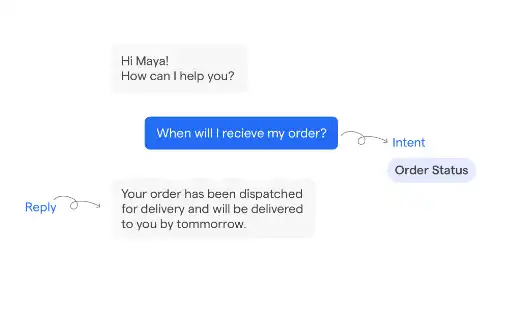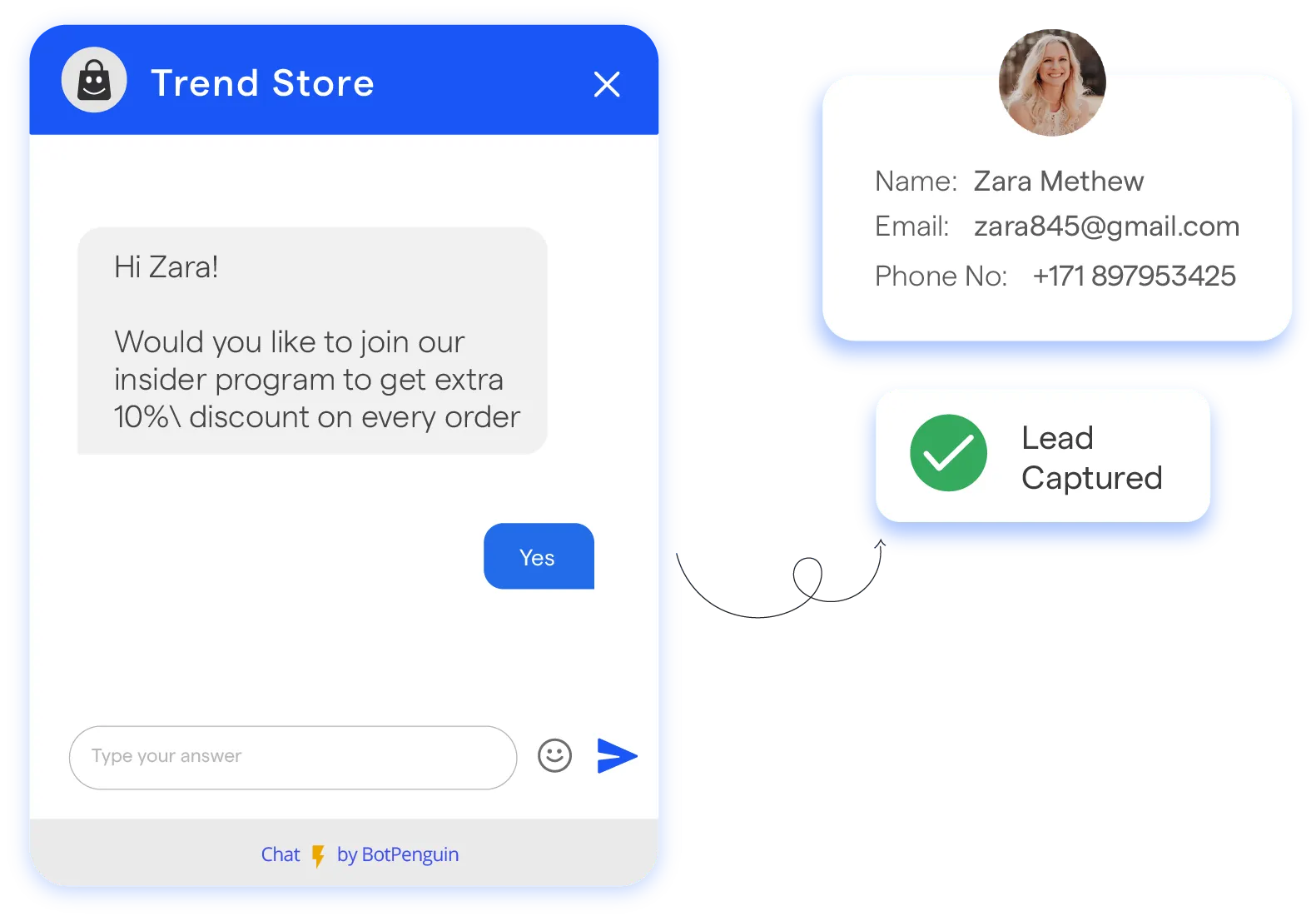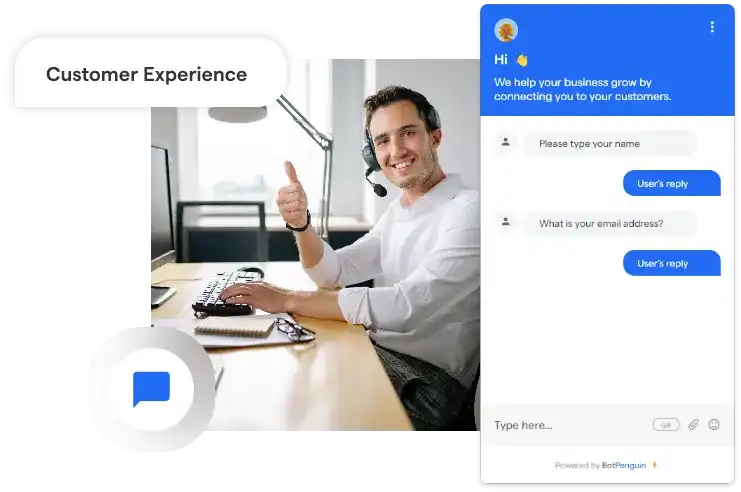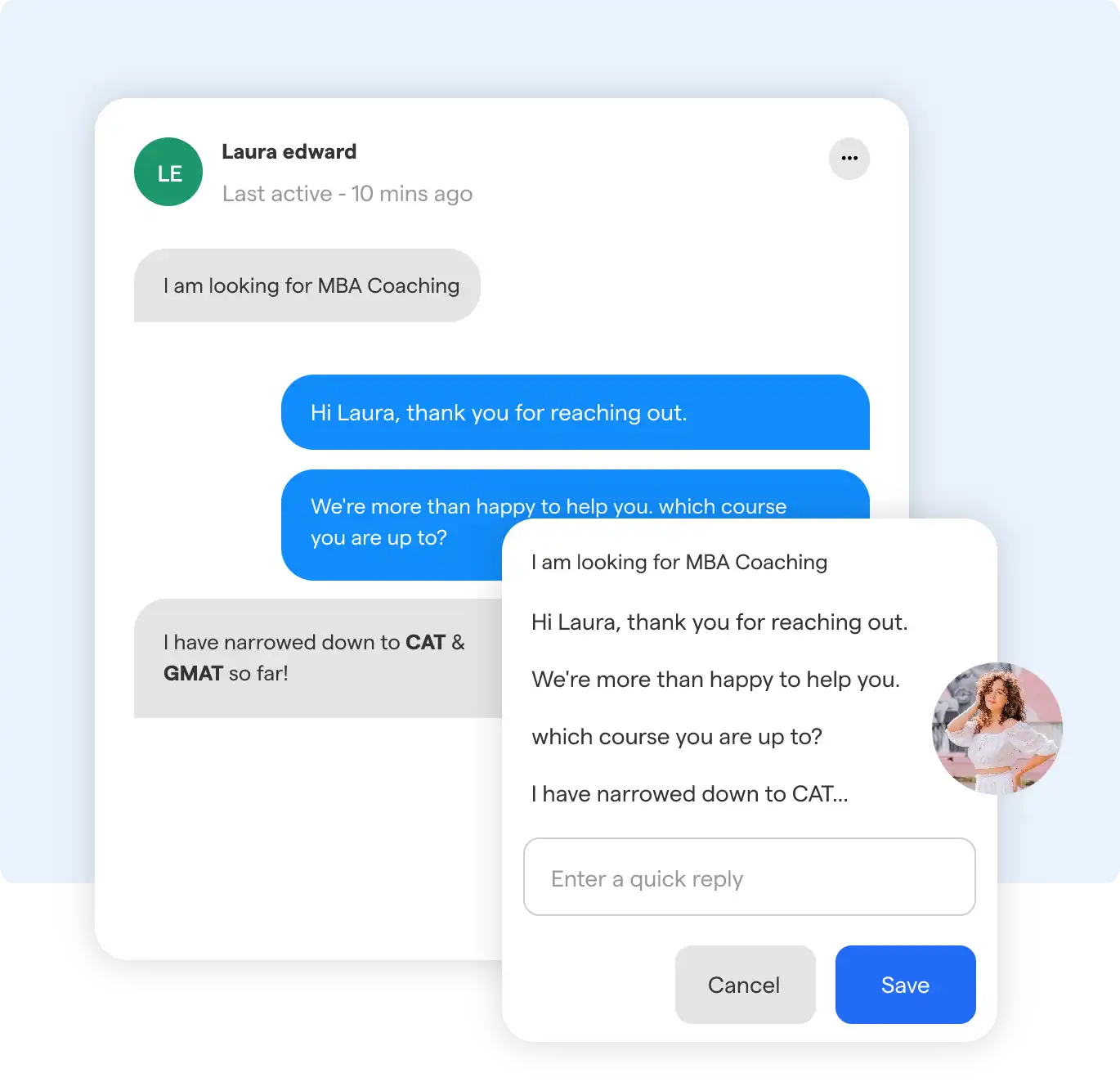Introduction
In AI-powered assistants, two prominent applications stand out: Customer Support Chatbots and Lead Generation Chatbots. As businesses increasingly incorporate AI chatbots, understanding the distinctions between these two types of chatbots becomes paramount.
Customer support chatbots are often hailed as the frontline of modern customer service. It is designed to handle inquiries, troubleshoot issues, and provide assistance to customers in real-time.
As per Statistica, 64% of businesses believe that chatbots allow them to provide a more customized support experience for their customers.
On the other hand, Lead Generation Chatbots are tailored to engage with potential customers, initiate conversations, and gather relevant information. These chatbots serve as proactive agents in attracting prospects, qualifying leads, and nurturing them through the sales funnel.
According to Outgrow, 36% of businesses use chatbots to improve their lead generation strategies.
While both types of chatbots harness AI technology to streamline operations and enhance user experiences, their functionalities and objectives diverge significantly.
This article will delve into the key differentiators, functionalities, and benefits and challenges associated with Customer Support Chatbots and Lead Generation Chatbots,.
Customer Support Chatbot vs Lead Generation Chatbot: Functionality and Purpose
In this section, you’ll find the key points of customer support chatbot vs. lead generation chatbot about functionality and purpose. Let’s look at them:
Customer Support Chatbot

Customer support chatbots are virtual assistants made to quickly and effectively respond to requests from customers and offer assistance. These chatbots are designed to understand natural language and provide thoughtful answers to various kinds of client questions.
Features and Capabilities
Customer support chatbots may provide outstanding customer service because of their many features and capabilities. Some of the important factors to consider are:
- Automated Responses: By instantly responding to frequently asked questions, customer service chatbots can reduce the workload for human agents.
- Availability Around-the-Clock: Unlike human agents, chatbots are always available, guaranteeing that clients may obtain help whenever and wherever they need it.
- Support for several channels: These chatbots may be connected with other messaging services, enabling users to communicate with them through the channels of their choice, such as social media, mobile applications, or websites.
- Personalization: Based on user data, customer support chatbots may customize their replies to give a more individualized and customized help experience.
How Customer Support Chatbots Assist Users
Customer service Chatbots are necessary for quickly and effectively resolving consumer concerns. They may:
- Frequently Asked Questions: Chatbots can save users time and effort by quickly responding to frequently asked questions.
- Lead Users through Processes: Chatbots can provide detailed instructions on difficult tasks such as account setup, product returns, and troubleshooting.
- Offer Real-time Support: Chatbots can identify serious issues and forward them to human operators for quick solutions by evaluating consumer inquiries
- Get Relevant Information: To help with problem-solving and follow-up action, customer service chatbots may obtain relevant data from clients, such as order data or contact details.
Examples of Common Customer Support Chatbot Use Cases
Chatbots for customer service are useful in several fields and businesses. Typical scenarios for use include:
- E-commerce: Assisting clients with questions about products, monitoring orders, and returns and refunds.
- Banks and Financial Institutions: Helping clients with card activation, fund transfers, and balance inquiries.
- Travel and Hospitality: Providing details about flights, hotel reservations, or suggested restaurants.
- Technology companies: It offers product documentation; assisting clients with setup; and resolving technical problems.
Lead Generation Chatbot

It's not an easy challenge to generate leads and evaluate potential clients. Chatbots that generate leads are meant to identify and filter potential consumers for companies. These chatbots motivate customers through the lead creation process, interact with them actively, and collect necessary information.
Features and Capabilities
Lead-generating chatbots can help collect and qualify leads because of their unique characteristics and capabilities. These consist of:
- Lead Capture Forms: Businesses can easily follow up with potential leads by using chatbots to gather user contact data through interactive forms
- Interactive Conversations: To get information and understand consumers' demands, lead-generation chatbots offer focused questions that create an engaging discussion.
- Lead Qualification: Chatbots can determine the quality and purpose of leads by posing qualifying questions. It helps organizations concentrate their efforts on the most potential customers.
- Smooth Integration: By connecting these chatbots with marketing automation platforms and customer relationship management (CRM) systems, lead management procedures may be simplified.
How Lead Generation Chatbots Capture and Qualify Leads
Chatbots for lead generation use several approaches and methods to efficiently collect and qualify leads. They may:
- Engage and Interact: Chatbots draw users in by sending them customized welcomes and having interactive dialogues that spark their curiosity.
- Answer Valuable Questions: Chatbots may learn a lot about consumers' tastes, requirements, and desires to buy by asking appropriate questions.
- Provide Personalized Suggestions: Chatbots can provide suggestions for certain products or services based on user input, which can enhance the probability of converting leads.
- Offer Incentives: By providing unique discounts, content downloads, or access to gated resources, chatbots could convince users to share their contact information.
By integrating a CRM with your chatbot you can set up drip campaigns and send bulk messages on platforms that are convenient for your customers. Because BotPenguin provides no code AI chatbots for multiple platforms like:
Examples of Common Lead Generation Chatbot Use Cases
Businesses in many different industries use lead-generating chatbots extensively to support their lead-generation initiatives. Here are a few such use cases:
- Real estate: Helping consumers locate ideal homes according to their preferences and collecting their contact information for future interaction.
- Insurance: assisting consumers in choosing an insurance plan and gathering data to generate customized insurance quotations.
- Education: Setting up contact information, assisting potential learners in researching course options, and arranging for campus visits or consultations.
- SaaS Companies: Set up demos, learn about the requirements of the leads, and qualify them by knowing what they need.
Customer Support Chatbot vs Lead Generation Chatbot: Benefits and Limitations
Understanding the different advantages and disadvantages of —customer support and lead generation—is important. Examining their advantages and disadvantages, giving you the knowledge you need to choose the chatbot that best meets your company's goals. Let's explore the unique benefits and limitations of these virtual teammates.
Benefits of Customer Support Chatbot

The benefits of customer support chatbot are the following:
- 24/7 Availability: Customer service chatbots are accessible around the clock, in comparison to human agents who have set business hours. This increases overall customer satisfaction by guaranteeing that clients may access support and answers to their questions whenever they need them.
- Quick and Effective Responses: Chatbots cut down on client wait times by giving immediate answers. They may take care of routine and simple inquiries, giving time to human agents to deal with more complicated matters. This increases overall customer service efficiency and speeds up response times.
- Scalability: Businesses can expand their customer support operations without adding more human staff because of chatbots' capacity to manage several conversations at once. This adaptability helps in satisfying client requests during busy times without sacrificing product quality.
- Consistency in Service: By sticking to predefined replies and scripts, chatbots provide consistent service. Ensuring that every client receives the same degree of assistance, helps reduce the differences that may occur when inquiries are handled by human agents.
Limitations and Challenges Faced by Customer Support Chatbots
Chatbots for customer service have many benefits, but they can have drawbacks and difficulties. Companies must be aware of these possible drawbacks:
- Complex Queries: Chatbots may find it difficult to respond to unusual or complex questions that call for human assistance. To guarantee customer satisfaction and issue resolution in such situations, smooth escalation to human agents is essential.
- Language and Contextual Understanding: Although natural language processing has advanced, chatbots may still have difficulty understanding the complexities of language and context. Customers may become upset as a result of inaccurate answers to their questions or misunderstanding of their requests.
- Lack of Empathy: When dealing with delicate or emotionally charged topics, chatbots may struggle due to their lack of human empathy. Establishing a clear escalation way for human agents is something that businesses should make sure that they do.
Suggested Reading:
The Future of Customer Support: AI Chatbot Consultancy
Best Practices for Optimizing Customer Support Chatbot Performance
Companies can use the following best techniques to increase the performance of customer service chatbots:
- Constant Improvement and Training: Chatbots should be taught how to handle difficult situations and updated with fresh information regularly. This guarantees that they stay updated and ready to provide accurate and useful answers.
- Smooth Human Handoff: To manage complicated requests or circumstances that call for individualized care, a smooth handoff procedure between chatbots and human agents must be put in place. By doing this, a seamless transition is ensured and client annoyance is avoided.
- User Input and Tracking: Get frequent feedback from clients on their interactions with chatbots. This knowledge may be used to pinpoint problem areas and offer helpful recommendations for improving chatbot function.
Benefits of Lead Generation Chatbot

Chatbots for lead generation provide several advantages that help businesses quickly find and buy new leads. Let's examine the benefits:
- Enhanced Lead Conversion: Chatbots designed to generate leads converse with consumers and collect relevant information. Businesses can improve lead conversion rates by better-maintaining leads and making personalized suggestions based on user requirements and interests.
- Saves Time and Money: By optimizing the lead creation process, chatbots reduce the need for human data entry. This reduces the qualification of leads and captures prices while saving time.
- Round-the-clock Lead generating: Businesses may obtain leads at any time by using lead-generating chatbots, which are accessible round the clock. By doing this, it is made sure that no leads are lost because of time zone variations or irregular business hours.
- Consistent Lead Qualification: Businesses can focus their efforts on the most promising leads by using chatbots that ask qualifying questions to filter out irrelevant leads. This lowers the amount of time lost on unqualified leads and increases overall sales efficiency.
Limitations and Challenges Faced by Lead Generation Chatbots
Lead-generating chatbots have many advantages, but they also have drawbacks and difficulties. Companies must be aware of these possible drawbacks:
- Lack of Human Judgement: Chatbots may find it difficult to understand the complexity or complicated buying signals that human agents can recognize easily. This occasionally leads to incorrect lead categorization or lost chances.
- Data Privacy and Security Concerns: Lead-generating chatbots collect and keep user data, giving rise to privacy and security concerns. Businesses should put strong data protection procedures in place and follow the relevant laws to get past these barriers.
Suggested Reading:
9 Best Chatbot Platforms for Lead Generation
Best Practices for Maximizing Lead Generation Chatbot Effectiveness
To maximize the performance of chatbots created to generate leads, companies have to include the below-recommended practices:
- Strategic and Targeted Lead Qualification: Create chatbot conversation flows that provide targeted questions to effectively determine the quality and purpose of leads. This guarantees that companies focus their attention on leads with a higher conversion rate.
- Personalized Offers and suggestions: Make advantage of the information collected by the chatbot to provide consumers with customized offers and suggestions. This improves user experience and raises the possibility of converting leads.
- Connect with CRM and Marketing Automation Systems: Easily connect lead generation chatbots to marketing automation platforms and Customer Relationship Management (CRM) systems. This guarantees an effortless transfer of new leads to the sales team and automates lead management procedures.
- Analyze and Improve Performance Continually: Keep an eye on indicators related to chatbot performance, such as conversion and lead capture rates. This enables companies to pinpoint problem areas and maximize the efficiency of chatbots.
Conclusion
In conclusion, the comparison between Customer Support Chatbots and Lead Generation Chatbots underscores the distinct roles they play in enhancing business operations.
Customer Service Chatbots excel in providing efficient and personalized assistance to customers. Thereby improving overall satisfaction and retention rates. Their ability to handle inquiries promptly, offer 24/7 support, and resolve issues autonomously significantly reduces the burden on human agents while ensuring consistent service quality.
Meanwhile, Lead Generation Chatbots prove invaluable in capturing and nurturing potential leads. Thereby fueling sales pipelines and driving revenue growth. Leveraging AI algorithms, they engage prospects in interactive conversations, qualifying them based on predefined criteria and seamlessly transitioning them through the sales funnel. Their proactive approach in initiating conversations and collecting valuable customer data empowers businesses to tailor their marketing strategies effectively. Doing this ultimately increases conversion rates and maximizes ROI.
While both types of chatbots leverage AI technology to streamline operations and enhance customer experiences, their focus areas and functionalities differ significantly. Therefore, the choice between Customer Support Chatbots and Lead Generation Chatbots should be guided by the specific objectives and priorities of the business.
Frequently Asked Questions (FAQs)
What is the primary purpose of a Customer Support Chatbot?
A Customer Support Chatbot primarily aims to assist customers by answering inquiries, resolving issues, and providing support, ultimately enhancing the customer service experience.
How does a Lead Generation Chatbot differ from a Customer Support Chatbot?
A Lead Generation Chatbot focuses on capturing and qualifying leads by engaging with potential customers, collecting information, and nurturing prospects for sales.
Can one chatbot perform both customer support and lead generation tasks simultaneously?
Yes, it's possible to create a hybrid chatbot, but it's essential to carefully design its functionalities to avoid confusion and optimize performance.
What industries can benefit from a Customer Support Chatbot?
Industries like e-commerce, healthcare, and technology find value in Customer Support Chatbots to enhance customer satisfaction and streamline support processes.
In what industries is a Lead Generation Chatbot particularly effective?
Lead Generation Chatbots are valuable in industries like real estate, insurance, and B2B sales, where lead qualification and conversion are critical.


